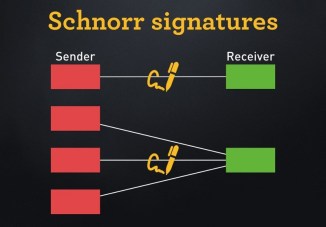The problem with Bitcoin’s scalability is well known. With the increase in the number of transactions, the network gets clogged up and there is an increase in waiting times and fees. One of the solutions could be the so-called Schnorr signatures.
For security reasons Bitcoin has been designed to mine one block every 10 minutes on average and, for the same reasons, it was decided not to increase the block size, which would compromise the decentralisation of the network. Developers’ efforts are mostly focused on applications that remain anchored to the blockchain but use it as little as possible, Lightning Network operates in a similar way.
To keep the original size of the blocks, it is necessary to work on optimising the available space, as well as optimising the data entered. There are numerous studies working to solve on-chain scalability.
Summary
Schnorr Signatures

One very interesting project, now at an advanced stage (also thanks to the adoption of SegWit) is called Schnorr’s Signature scheme, which aims to optimise the space occupied by signatures in the blocks.
Signatures are obviously required for successful transactions, which unfortunately take up a lot of space in the blocks. This becomes particularly problematic when executing multiple transactions from several addresses towards just one, as each of these transactions requires its own signature.
The space used by the signature data increases the size of the transactions and thus the fees to be paid to the miners.
Bitcoin currently uses a signature scheme called ECDSA to authorise transactions. Schnorr’s signature scheme is already known but has never been used due to patent reasons. This scheme has an algebraic structure simpler than ECDSA and therefore allows improvements such as compact multi-signatures.
It is estimated that this protocol update may reduce the use of blockchain storage space and network bandwidth by at least 25%. In essence, there would be a huge efficiency gain.
Advantages for the Bitcoin protocol
It is also possible to set that a certain Bitcoin can only be spent if the participants agree with each other, thanks to a mechanism called multi-signatures. The current implementation simply consists of chaining the signatures of different people.
With Schnorr’s multi-signatures it is possible to compress the signatures of all participants into a single signature. This allows having a huge advantage in terms of space. It is also possible to authorise all outputs with a single signature.
The advantages in terms of privacy
For multi-signatures involving several participants, it is possible to aggregate the public keys into a single key. The key is indistinguishable from a classic public key. This makes it impossible to determine whether the spending of a given bitcoin has been authorised by a single person or by several persons. This new method may allow multiple signatories to merge their signatures into one. This results in significant space savings and increased confidentiality.
There are still numerous studies and tests to be carried out with this new model of signatures. When everything is ready a BIP (Bitcoin Improvement Proposal) will surely be compiled. A large consensus is expected from the community and adoption will take place through a soft fork. Schnorr is just one of many implementations aimed at improving Bitcoin’s privacy, scalability and confidentiality. Soon, there will be other solutions as well.


